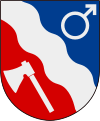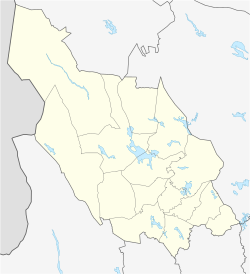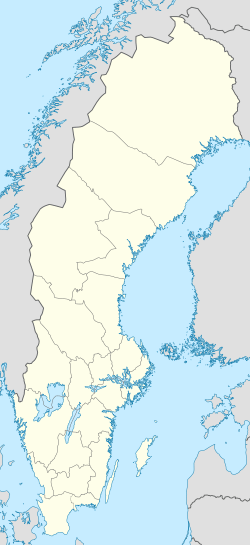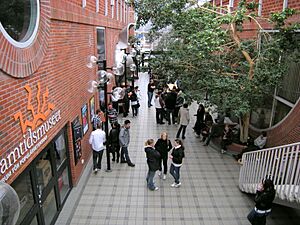Borlänge facts for kids
Quick facts for kids
Borlänge
|
||
|---|---|---|
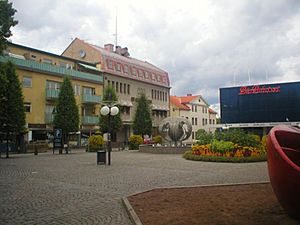
Sveatorget in Borlänge in 2005
|
||
|
||
| Country | ||
| Province | Dalarna | |
| County | Dalarna County | |
| Municipality | Borlänge Municipality | |
| Founded | 1944 | |
| Area | ||
| • Total | 34.36 km2 (13.27 sq mi) | |
| Elevation | 151 m (495 ft) | |
| Population
(2017)
|
||
| • Total | 44,898 | |
| • Density | 1,306.69/km2 (3,384.3/sq mi) | |
| Time zone | UTC+1 (CET) | |
| • Summer (DST) | UTC+2 (CEST) | |
| Postal codes |
781 xx, 784 xx
|
|
| Climate | Dfb | |
Borlänge is a lively town in Dalarna County, Sweden. About 44,898 people live here as of 2020. It is the main town of the Borlänge Municipality, which has a total population of around 51,604 people.
Contents
History of Borlänge
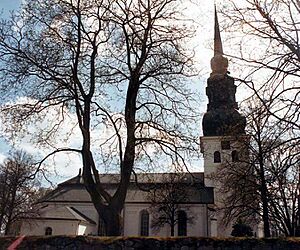
Borlänge began as a tiny village, first mentioned around the 1390s. It stayed small until about 1870. A big change happened in 1872 when the Domnarfvets Jernverk, an ironworks in the nearby village of Domnarvet, started to be built.
In 1875, a railway opened that connected Falun and Ludvika, passing through Borlänge. Because of its new railway station, Borlänge became very important for serving the ironworks.
In 1898, Borlänge was given special rights by the Swedish government to become a market town (a place where people could trade goods). At that time, about 1,300 people lived there. The Stora Kopparbergs Bergslag, which owned the ironworks, also built a papermill in a nearby village called Kvarnsveden in 1898.
In 1944, the market town of Borlänge joined with the industrial towns of Domnarvet and Kvarnsveden to become the City of Borlänge. Later, in 1971, the larger Borlänge Municipality was created when the Stora Tuna municipality merged with the city.
In the early 1970s, both the Kvarnsvedens Pappersbruk paper mill and the Domnarvets Jernverk steel mill needed many workers.
People of Borlänge
Borlänge is home to many different people. As of 2017, about 51,604 people lived in Borlänge Municipality. Over 11,000 residents have a foreign background, meaning they or their parents were born outside Sweden. Many of these residents come from Asia, Africa, other Nordic countries, and other parts of Europe.
In the 1990s, many people came to Borlänge from Southern Europe. Later, in the 2000s, immigrants mainly arrived from Somalia, Iraq, and Turkey. More recently, many newcomers have come from Syria and Eritrea.
Here are some of the most common countries of origin for people born outside Sweden who live in Borlänge:
 Somalia (3,114 people)
Somalia (3,114 people) Finland (1,570 people)
Finland (1,570 people) Syria (1,032 people)
Syria (1,032 people) Iraq (1,028 people)
Iraq (1,028 people) Turkey (926 people)
Turkey (926 people) Eritrea (350 people)
Eritrea (350 people) Thailand (322 people)
Thailand (322 people) Iran (240 people)
Iran (240 people) Ex-Yugoslavia (197 people)
Ex-Yugoslavia (197 people) Norway (174 people)
Norway (174 people)
What Borlänge Does
Borlänge has always been an industrial town. It is known for the iron mill of Domnarvet (SSAB) and the paper mill of Kvarnsveden (Stora Enso). The city is also home to the main office for a big government agency, the National Swedish Transport Administration (Trafikverket).
Sports in Borlänge
Borlänge has a successful football (soccer) team called IK Brage. This team has played 18 seasons in Sweden's top league, Allsvenskan. They play in green and white at the Domnarvsvallen Stadium. Another well-known soccer team from Borlänge is Dalkurd FF, which has fans both in Sweden and abroad.
Other sports clubs in Borlänge include:
- Forssa BK
- IF Tunabro
- Islingby IK
- Kvarnsvedens IK
- Stora Tuna OK
In 2013, a Somali national bandy team was formed in Borlänge. They aimed to play in the 2014 Bandy World Championship. Borlänge was also the main place for the 2008 Women's Bandy World Championship.
In 1999, a large orienteering competition called O-Ringen was held near Borlänge. Over 15,000 people took part. The 1993 World Gliding Championships also took place at the Borlänge Airport.
Music in Borlänge
Just like its nearby city, Falun, music is a big part of Borlänge. Many popular Swedish musicians have come from here, such as Mando Diao, Sugarplum Fairy, and Miss Li. You can even study popular music at BoomTown Music Education, which is part of Luleå University of Technology.
The yearly Peace & Love music festival used to be held in Borlänge.
Famous Music Groups from Borlänge
- Stonewall Noise Orchestra (rock band)
- Mando Diao (rock band)
- Twilight Force (power metal band)
- Astral Doors (heavy metal band)
- Dozer (stoner rock band)
- Greenleaf (stoner rock band)
- Sator (rock band)
- Rootvälta (reggae band)
- Sugarplum Fairy (rock band)
- Anekdoten (prog band)
Famous People from Borlänge
Many notable people have come from Borlänge, including:
- Simon Aspelin, a tennis player
- Jens Bergenström, a hockey player
- Jussi Björling, a famous singer (tenor)
- Mattias Ekholm, an NHL Hockey Player for the Edmonton Oilers
- Tomas Forslund, an ice hockey player
- Per Fosshaug, a bandy player
- Lars Frölander, a swimmer
- Nils Patrik Johansson, a heavy metal singer
- Lars Jonsson, an ice hockey player
- Gabriel Karlsson, a hockey player
- Miss Li, a musician
- Lasse Nilsson, a football player
- Gustaf Norén, a musician
- Mattias Ritola, a hockey player
- Johan Olof Wallin, an archbishop, poet, and psalmist
Education in Borlänge
Borlänge offers several schools and learning opportunities:
- Dalarna University College
- Soltorgsgymnasiet
- Hagagymnasiet
- Rytmus musikgymnasium
- Erikslundgymnasiet
- NTI Gymnasiet
Images for kids


